The story starts in May, when a fellow UKC-er, Alex, contacted me for info on climbing and camping in the Ariège Pyrénées. After arriving in France he e-mailed me asking if I wanted to do Les Enfants de la Dalle on the Dent d'Orlu. Naturally I said yes without thinking twice, but after checking out the route on the internet (the first ascent was done after my copy of the guide was published) I started to have serious misgivings – it is no less than 25 pitches long, plus another 150m of hard scrambling - a total of over 1,100 metres (3,700 feet) of climbing. In my current state of unfitness that seemed like complete madness, so when Alex phoned me to arrange the details we agreed on a shorter climb.
On the last Saturday in August I arrived with husband and two small children at the Orlu campsite, where we had booked a chalet for the weekend. The Dent looked magnificent, and one look at the new guidebook had me throwing my misgivings to the wind - Les Enfants de la Dalle was too good to resist. It's allegedly the best multi-pitch route in the Ariège Pyrénées, the climbing is technically reasonable (the hardest pitch is F6a+), and the pictures in the guidebook were mouthwatering. An abseil descent is possible right up to pitch 18, though I agreed with Alex that if we were too slow we would bag it well before then. That night I reckoned our chances of completing the route at no more than 20%. Still, it was worth a shot.
The next morning we left the campsite at 6.15am in pitch darkness and started the very steep walk-in with head-torches. We aimed to complete the route in 9-10 hours, allowing ourselves a margin over the guidebook timetable of 8 hours, and the walk off would take another hour. In order to avoid the long and difficult descent back to our starting point, we had arranged for Alex's wife to wait for us in the car-park on the other side of the mountain.
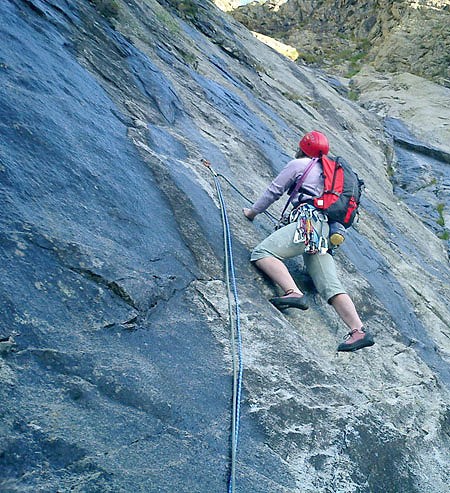
On arriving at the start of the route we found that the first two pitches were suffering badly from seepage, following torrential rain two days before. However the rock above looked drier so we decided to go for it. Alex led the first F5c+ pitch, climbing quickly at first then more slowly as the moves got thinner and the rock wetter. The route is well equipped for its type, but the protection is still relatively sparse, typically 5-8 bolts for a 40-45 metre pitch. The final section to the belay looked particularly gripping: technical moves on damp rock with few positive holds, with a big fall the price to pay for any mistake. Fortunately Alex made it, and I followed, finding the moves slippery but not too bad with the rope above me. It was quite a different story once I set off leading up the next, very similar pitch. The wet rock really rattled me and there were several long reaches for good holds, no problem in the dry but a major obstacle on wet rock – moving up on wet smears with damp slopers in both hands was the stuff of nightmares. Add to that the unfamiliar sensation of climbing with a rucksack containing shoes, food and 3 litres of water, and it was not one of the most pleasurable climbing experiences of my life.
Arriving safely at the belay I was more relieved and depressed than pleased; I reckoned our chances of completing the route had fallen to just above zero. We had taken an hour and a quarter to climb just 90 metres, well behind our plan of 20-25 minutes a pitch. We still had over 1,000 metres to go and I was already mentally and physically tired.
Our mood improved quickly over the next six pitches, which were dry and felt much easier. The climbing was very good and clean, we were moving quickly, and imagined obstacles – such as the aid move to reach the sixth belay – proved very straightforward. Pitch 8 in particular was absolutely magnificent: 40 metres of sustained granite slab climbing at F5c+. The bolts were relatively spaced except on the hardest sections, but both of us had our heads in gear by now, and we were feeling pretty confident. My only concern was my physical condition - I was getting tired, especially seconding, when I knew that I needed to move as fast as possible. It was reassuring to know that we had 250 metres of easier climbing ahead of us (F5b+), before we faced what would undoubtedly be the make-or-break pitch: a sustained wall graded F6a+. Both of us are more than capable of climbing at that grade under normal conditions, but I was keenly aware of the toll that the preceding 550 metres of climbing had taken. 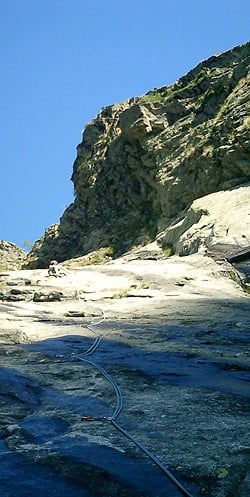
It was Alex's lead. He made the first half of the pitch look easy, but obviously found the climbing above very precarious: thin technical moves up a shallow groove, left onto a rib and through a small overhang. On the plus side, it was less steep than it had appeared from below. When it was my turn, I found the climbing tricky, but more amenable than I expected, though it took me a few minutes to solve the fingery move through the overlap. As I reached the belay, we were both confident that we were going to get up the route.
After some easier climbing, steeper than the lower slabs but with good holds, the next obstacle was pitch 18, which would take us up onto the summit ridge. It was also the point of no return, beyond which an abseil descent would be impossible. It was my lead, but I was starting to feel very tired, and the layback crack at the start of the pitch looked quite strenuous. Happily, with a month of climbing long multi-pitch routes under his belt, Alex was still feeling fine, and he was happy to take it on. It was with a feeling of great relief that I joined him on the belay: we were on the east ridge of the Dent, and the summit was almost in sight.
Unfortunately both of us had considerably underestimated the final seven pitches. It felt extremely exposed, with vertiginous views down both the south east and the east faces of the Dent, the bolts were now few and far between (though we were able to supplement them with a couple of friends and some slings), there was some loose rock and a fair bit of mud, route-finding was not always obvious, and the climbing felt harder than we had anticipated. Exhausted, I gave up another F5c lead to Alex, and once pulled on a quick draw on a tricky balancy traverse – I was aware that time was slipping away and that ethics were less important than getting to the summit. 
By just after 6pm, around 10 hours after we had started climbing, we had completed the 25 pitches of the route. The remaining section of the ridge was much easier, F3, and we had assumed that we would be able to move together. However, the extreme exposure on the narrow ridge, combined with the risks presented by loose rock and mud, forced us to pitch two more full rope lengths before we could start moving together in moderate safety over the last 150 metres. From the end of the route to the top of the Dent took us an unexpected extra hour. We were now well behind schedule, and we were worrying about whether Alex's wife would still be waiting for us in the car park.
The descent felt long and hard, though it's the "tourist path" up the Dent and only takes an hour in good conditions. Unfortunately, after the rain of the previous week, the first, steepest section was treacherous, and I went down large sections of it on my backside (Alex, a former fell-runner, ran down it like a mountain goat). The rest was just a plod, but I was extremely tired by now, my legs felt like jelly and my blood sugar was very low (I had drunk plenty of water but found it hard to take time out to eat during the climb). I was also very anxious about what we would do if Alex's wife wasn't in the car park. When I saw her coming up the path towards me I had never been so happy to see anyone in my life.
The epilogue: 36 hours later, Alex was out mountain biking while I required several points of aid to get up the stairs. The moral: unless you are properly fit and have considerable experience of long routes, Les Enfants de la Dalle is not to be underestimated. The climbing is relatively easy, but there is an awful lot of it! But for a fit and competent party, it's an awesome route and a truly unforgettable day's climbing.
Information
The route 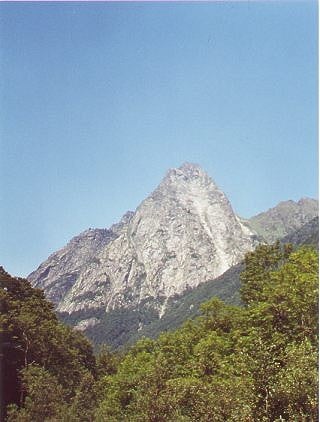
Les Enfants de la Dalle, TD, 6a+ (5c obligatoire), approximately 1,100 metres of climbing on the South East face of the Dent d'Orlu in the Ariège Pyrénées. The route is 25 pitches long, but the final 250 metres of summit ridge are extremely exposed and most climbers will feel safer climbing a further 2 pitches before moving together for the final 150 metres.
Timing: The guidebook suggests 8 hours of climbing, however this does not include the final section of the summit ridge (which took us about an hour). Based on our experience it would be sensible to allow 10-12 hours from the base of the route to the summit cairn.
Approach: around 50 minutes of steep walking from the Orlu side. 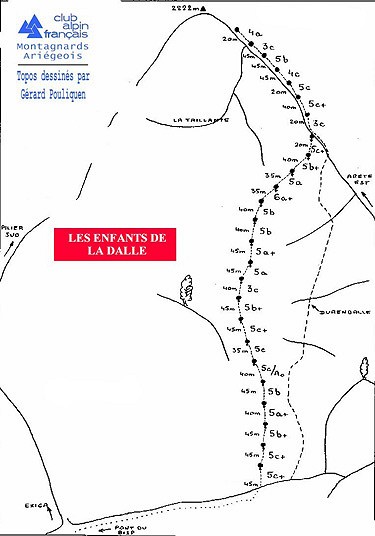
Equipment: The first 18 pitches and all the belays are fully equipped; the harder moves are generally well protected but easier sections are run-out. The final 7 pitches along the East Ridge are more sparsely bolted. Take 50 metre double ropes, 11 quickdraws, 2-3 small friends and some long slings for the ridge section, plus locking krabs for the belays. You will need at least 2.5-3 litres of water per person.
The descent: escape by abseil is possible up to pitch 18. However, an abseil descent would be serious or even impossible in heavy rain as the lower pitches turn into a waterfall. Once you reach the East Ridge, the only escape possible is via the summit. From the summit cairn, there are two possible descents: the tourist path down to the carpark above Ascou in about an hour (highly recommended - second car required) or a longer descent back to the base of the SE face. The latter requires careful route-finding and prior reconnaissance is recommended.
How to get there
By air to Toulouse (Easyjet, Flybe, British Airways) or Carcassonne (Ryanair), then approximately 1.5 hours by car to Orlu or Ascou via Pamiers, Foix and Ax-les Thermes.
By ferry and car, and taking toll motorways, allow approximately 13-14 hours driving time from Calais.
When to go
June to September for the Dent d'Orlu itself (the season may extend into May and October depending on the weather). However, there are year-round climbing possibilities elsewhere in the Ariège valley, including some multi-pitch routes at Sinsat and Calamès that are often climbable in winter.
Where to stay
If you plan to climb mainly on the Dent d'Orlu, there are campsites at Orlu (convenient for the S and SE faces) and Ascou (convenient for the E face). The Orlu campsite also has well-appointed 6-bed chalets.
If you prefer to mix mountain routes with some sport climbing, there are alternative camping possibilities further down the Ariège valley, in the Tarascon area. On unsettled days, the weather is likely to be much better here than at Orlu.
If you like your creature comforts, there is an English-run bed-and-breakfast near Foix – see . www.climbariege.co.uk
Other climbing in the area
The Dent d'Orlu has many shorter and easier multi-pitch climbs which are recommended as a warm-up before attempting any of the very long routes. The routes on the East face finish at the summit but are less committing (10-12 pitches). They also receive more shade.
There are a number of relatively easy multi-pitch limestone routes at Calamès, and more serious and longer undertakings at the Quié de Sinsat, including some very difficult routes involving both hard aid and grade 7 free climbing.
There are also many sport-climbing crags in the area catering for all standards.
The guidebook
J D Achard's 2002 guide to the Dent d'Orlu is indispensable and, along with other topos for the area, can usually be purchased at climbing shops in Toulouse Labège (Intersport, Le Vieux Campeur), Pamiers (Intersport), Foix (Décathlon) and Ax-les-Thermes (Télémark-Pyrénées).
Topos for the Dent d'Orlu and many other crags in the Ariège are available on-line at: www.cafma.free.fr. 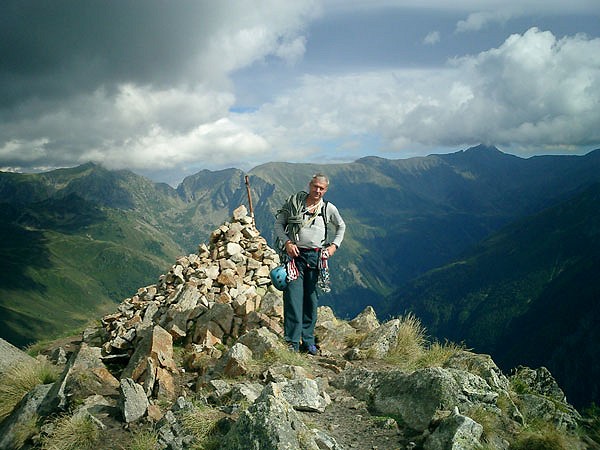
Alison Cowley has been climbing for 17 years. Formerly a keen trad climber with a soft spot for British seacliffs, she now lives in the Pyrénées.
Alex Pryor lives in the Peak District and has been climbing for over 30 years. He prefers long routes, and claims to find anything under 12 pitches rather short.

Comments